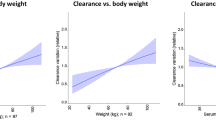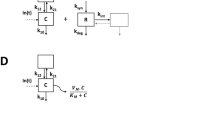Abstract
Background and Objective
Dosing of therapeutic monoclonal antibodies (mAbs) is often based on body size, with the perception that body size-based dosing would reduce inter-subject variability in drug exposure. However, most mAbs are target specific with a relatively large therapeutic window and generally a small contribution of body size to pharmacokinetic variability. Therefore, the dosing paradigm for mAbs should be assessed in the context of these unique characteristics. The objective of this study was to review the current dosing strategy and to provide a scientific rationale for dosing of mAbs using a modelling and simulation approach.
Methods
In this analysis, the body weight-based or body weight-independent (fixed) dosing regimens for mAbs were systematically evaluated. A generic two-compartment first-order elimination model was developed. Individual or population pharmacokinetic profiles were simulated as a function of the body weight effects on clearance (θbw_cl) and on the central volume of distribution (θbw_vl). The variability in exposure (the area under the serum concentration-time curve [AUC], trough serum concentration [Cmin] and peak serum concentration [Cmax]) was compared between body weight-based dosing and fixed dosing in the entire population. The deviation of exposure for light and heavy subjects from median body weight subjects was also measured. The simulation results were then evaluated with clinical pharmacokinetic characteristics of various mAbs that were given either by body weight-based dosing or by fixed dosing in the case study.
Results
Results from this analysis demonstrated that exposure variability was dependent on the magnitude of the body weight effect on pharmacokinetics. In contrast to the conventional assumption, body weight-based dosing does not always offer advantages over fixed dosing in reducing exposure variability. In general, when the exponential functions of θbw_cl and θbw_vl in the population pharmacokinetic model are <0.5, fixed dosing results in less variability and less deviation than body weight-based dosing; when both θbw_cl and θbw_vl are >0.5, body weight-based dosing results in less variability and less deviation than fixed dosing. In the scenarios when either θbw_cl or θbw_vl is >0.5, the impact on exposure variability is different for each exposure measure. The case study demonstrated that most mAbs had little effect or a moderate body weight effect (θbw_cl and θbw_vl <0.5 or ∼0.5). The difference of variability in exposure between body weight-based and fixed dosing is generally less than 20% and the percentages of deviation for light and heavy subpopulations are less than 40%.
Conclusions
The analysis provided insights into the conditions under which either fixed or body weight-based dosing would be superior in reducing pharmacokinetic variability and exposure differences between light and heavy subjects across the population. The pharmacokinetic variability introduced by either dosing regimen is moderate relative to the variability generally observed in pharmacodynamics, efficacy and safety. Therefore, mAb dosing can be flexible. Given many practical advantages, fixed dosing is recommended to be the first option in first-in-human studies with mAbs. The dosing strategy in later stages of clinical development could then be determined based on combined knowledge of the body weight effect on pharmacokinetics, safety and efficacy from the early clinical trials.








Similar content being viewed by others
References
Dirks NL, Meibohm B. Population pharmacokinetics of therapeutic monoclonal antibodies. Clin Pharmacokinet 2010 Oct 1; 49(10): 633–59
Mould DR, Green B. Pharmacokinetics and pharmacodynamics of monoclonal antibodies: concepts and lessons for drug development. BioDrugs 2010 Feb 1; 24(1): 23–39
Gurney H. Dose calculation of anticancer drugs: a review of the current practice and introduction of an alternative. J Clin Oncol 1996 Sep; 14(9): 2590–611
Mathijssen RH, de Jong FA, Loos WJ, et al. Flat-fixed dosing versus body surface area based dosing of anticancer drugs in adults: does it make a difference? Oncologist 2007 Aug; 12(8): 913–23
Frey N, Grange S, Woodworth T. Population pharmacokinetic analysis of tocilizumab in patients with rheumatoid arthritis. J Clin Pharmacol 2010 Jul; 50(7): 754–66
Arzerra (ofatumumab) injection for intravenous infusion: US prescribing information [online]. Available from URL: http://us.gsk.com/products/assets/us_arzerra.pdf [Accessed 2011 Dec 7]
Lu JF, Bruno R, Eppler S, et al. Clinical pharmacokinetics of bevacizumab in patients with solid tumors. Cancer Chemother Pharmacol 2008 Oct; 62(5): 779–86
Mould DR, Baumann A, Kuhlmann J, et al. Population pharmacokinetics-pharmacodynamics of alemtuzumab (Campath) in patients with chronic lymphocytic leukaemia and its link to treatment response. Br J Clin Pharmacol 2007 Sep; 64(3): 278–91
Dirks NL, Nolting A, Kovar A, et al. Population pharmacokinetics of cetuximab in patients with squamous cell carcinoma of the head and neck. J Clin Pharmacol 2008 Mar; 48(3): 267–78
Fukushima Y, Charoin J-E, Brewster M, et al. Population pharmacokinetic analysis of trastuzumab (Herceptin®) based on three different dosing regimens [abstract no. 1121]. Sixteenth Meeting, Population Approach Group in Europe; 2007 Jun 13–15; Copenhagen [online]. Available from URL: http://www.page-meeting.org/default.asp?abstract=1121 [Accessed 2011 Dec 7]
Weisman MH, Moreland LW, Furst DE, et al. Efficacy, pharmacokinetic, and safety assessment of adalimumab, a fully human anti-tumor necrosis factor-alpha monoclonal antibody, in adults with rheumatoid arthritis receiving concomitant methotrexate: a pilot study. Clin Ther 2003 Jun; 25(6): 1700–21
Ilaris® (canakinumab): US prescribing information [online]. Available from URL: http://www.pharma.us.novartis.com/product/pi/pdf/ilaris_ppi.pdf [Accessed 2011 Dec 7]
Dowell JA, Korth-Bradley J, Liu H, et al. Pharmacokinetics of gemtuzumab ozogamicin, an antibody-targeted chemotherapy agent for the treatment of patients with acute myeloid leukemia in first relapse. J Clin Pharmacol 2001 Nov;41(11): 1206–14
Sun YN, Lu JF, Joshi A, et al. Population pharmacokinetics of efalizumab (humanized monoclonal anti-CD11a antibody) following long-term subcutaneous weekly dosing in psoriasis subjects. J Clin Pharmacol 2005 Apr; 45(4): 468–76
Cox DS, Kleiman NS, Boyle DA, et al. Pharmacokinetics and pharmacodynamics of argatroban in combination with a platelet glycoprotein IIB/IIIA receptor antagonist in patients undergoing percutaneous coronary intervention. J Clin Pharmacol 2004 Sep; 44(9): 981–90
Xu Z, Seitz K, Fasanmade A, et al. Population pharmacokinetics of infliximab in patients with ankylosing spondylitis. J Clin Pharmacol 2008 Jun; 48(6): 681–95
Xu Z, Vu T, Lee H, et al. Population pharmacokinetics of golimumab, an anti-tumor necrosis factor-alpha human monoclonal antibody, in patients with psoriatic arthritis. J Clin Pharmacol 2009 Sep; 49(9): 1056–70
Zhou H, Jang H, Fleischmann RM, et al. Pharmacokinetics and safety of golimumab, a fully human anti-TNF-alpha monoclonal antibody, in subjects with rheumatoid arthritis. J Clin Pharmacol 2007 Mar; 47(3): 383–96
Kovarik JM, Nashan B, Neuhaus P, et al. A population pharmacokinetic screen to identify demographic-clinical covariates of basiliximab in liver transplantation. Clin Pharmacol Ther 2001 Apr; 69(4): 201–9
Soliris™ (eculizumab): US prescribing information [online]. Available from URL: http://www.accessdata.fda.gov/drugsatfda_docs/label/2007/125166lbl.pdf [Accessed 2011 Dec 7]
Zhu Y, Hu C, Lu M, et al. Population pharmacokinetic modeling of ustekinumab, a human monoclonal antibody targeting IL-12/23p40, in patients with moderate to severe plaque psoriasis. J Clin Pharmacol 2009 Feb; 49(2): 162–75
Synagis® (palivizumab) for intramuscular administration: US prescribing information [online]. Available from URL: http://www.medimmune.com/pdf/products/synagis_pi.pdf [Accessed 2011 Dec 7]
Hutchinson M. Natalizumab: a new treatment for relapsing remitting multiple sclerosis. Ther Clin Risk Manag 2007 Jun; 3(2): 259–68
Ma P, Yang BB, Wang YM, et al. Population pharmacokinetic analysis of panitumumab in patients with advanced solid tumors. J Clin Pharmacol 2009 Oct; 49(10): 1142–56
Hayashi N, Tsukamoto Y, Sallas WM, et al. A mechanism-based binding model for the population pharmacokinetics and pharmacodynamics of omalizumab. Br J Clin Pharmacol 2007 May; 63(5): 548–61
Clinical pharmacology review of BLA 97-0736 [online]. Available from URL: http://www.fda.gov/downloads/Drugs/DevelopmentApprovalProcess/HowDrugsareDevelopedandApproved/ApprovalApplications/TherapeuticBiologicApplications/ucm113472.pdf [Accessed 2011 Dec 7]
Fang AF, Palmer JN, Chiu AG, et al. Pharmacokinetics of azithromycin in plasma and sinus mucosal tissue following administration of extended-release or immediate-release formulations in adult patients with chronic rhinosinu-sitis. Int J Antimicrob Agents 2009 Jul; 34(1): 67–71
Vollmer T, Blight AR, Henney 3rd HR, et al. Steady-state pharmacokinetics and tolerability of orally administered fampridine sustained-release 10-mg tablets in patients with multiple sclerosis: a 2-week, open-label, follow-up study. Clin Ther 2009 Oct; 31(10): 2215–23
Deng R, Iyer S, Theil FP, et al. Projecting human pharmacokinetics of therapeutic antibodies from nonclinical data: what have we learned? MAbs 2011 Jan-Feb; 3(1): 61–6
Mahmood I. Pharmacokinetic allometric scaling of antibodies: application to the first-in-human dose estimation. J Pharm Sci 2009 Oct; 98(10): 3850–61
Klement G, Huang P, Mayer B, et al. Differences in therapeutic indexes of combination metronomic chemotherapy and an anti-VEGFR-2 antibody in multidrug-resistant human breast cancer xenografts. Clin Cancer Res 2002 Jan; 8(1): 221–32
Mager DE, Jusko WJ. General pharmacokinetic model for drugs exhibiting target-mediated drug disposition. J Pharmacokinet Pharmacodyn 2001 Dec; 28(6): 507–32
Shi R, Li C, Zhang S, et al. Fixed dosing versus body size-based dosing of therapeutic proteins and peptides in adults [abstract]. 111th Annual Meeting, American Society for Clinical Pharmacology and Therapeutics; 2010 Mar 17–20; Atlanta (GA)
Ng CM, Lum BL, Gimenez V, et al. Rationale for fixed dosing of pertuzumab in cancer patients based on population pharmacokinetic analysis. Pharm Res 2006 Jun; 23(6): 1275–84
Baker SD, Verweij J, Rowinsky EK, et al. Role of body surface area in dosing of investigational anticancer agents in adults, 1991–2001. J Natl Cancer Inst 2002 Dec 18; 94(24): 1883–8
Wang DD, Zhang S, Zhao H, et al. Fixed dosing versus body size-based dosing of monoclonal antibodies in adult clinical trials. J Clin Pharmacol 2009 Sep; 49(9): 1012–24
Brainard J, Burmaster DE. Bivariate distributions for height and weight of men and women in the United States. Risk Anal 1992 Jun; 12(2): 267–75
Gibaldi M, Perrier D, editors. Pharmacokinetics. 2nd ed. New York: Marcel Dekker, 1982
**n Y, Xu L, Bai S, et al. Fixed dosing evaluation of pertuzumab in cancer patients from phase I and II studies [abstract]. 111th Annual Meeting, American Society for Clinical Pharmacology and Therapeutics; 2010 Mar 17–20; Atlanta (GA)
Gupta M, Lorusso PM, Wang B, et al. Clinical implications of pathophysio-logical and demographic covariates on the population pharmacokinetics of trastuzumab emtansine, a HER2-targeted antibody-drug conjugate, in patients with HER2-positive metastatic breast cancer. J Clin Pharmacol. Epub 2011 Sep 27
Gibiansky L, Gibiansky E. Target-mediated drug disposition model for drugs that bind to more than one target. J Pharmacokinet Pharmacodyn 2010 Aug; 37(4): 323–46
Krippendorff BF, Kuester K, Kloft C, et al. Nonlinear pharmacokinetics of therapeutic proteins resulting from receptor mediated endocytosis. J Pharmacokinet Pharmacodyn 2009 Jun; 36(3): 239–60
Mosteller RD. Simplified calculation of body-surface area. N Engl J Med 1987 Oct 22; 317(17): 1098
European Medicines Agency. ICH topic E11: clinical investigation of medicinal products in the paediatric population [document reference CPMP/ICH/2711/99]. London: European Medicines Agency, 2001 Jan [online]. Available from URL: http://www.emea.europa.eu/docs/en_GB/document_library/Scientific_guideline/2009/09/WC500002926.pdf [Accessed 2011 Dec 7]
US Food and Drug Administration [FDA]. Guidance for industry: E11 clinical investigation of medicinal products in the pediatric population. Rockville (MD): FDA, 2000 Dec [online]. Available from URL: http://www.fda.gov/downloads/RegulatoryInformation/Guidances/ucm129477.pdf [Accessed 2011 Dec 7]
Acknowledgements
The authors wish to thank Dr Paul Fielder and Dr Frank-Peter Theil from Genentech Inc. and Dr Chee Ng from the University of Pennsylvania for providing valuable technical advice.
All authors are employees of Genentech/Roche and hold stock or stock options in Roche. No funding was used to prepare this manuscript. The authors have no conflicts of interest that are directly relevant to the content of this manuscript.
Author information
Authors and Affiliations
Corresponding authors
Rights and permissions
About this article
Cite this article
Bai, S., Jorga, K., **n, Y. et al. A Guide to Rational Dosing of Monoclonal Antibodies. Clin Pharmacokinet 51, 119–135 (2012). https://doi.org/10.2165/11596370-000000000-00000
Published:
Issue Date:
DOI: https://doi.org/10.2165/11596370-000000000-00000




